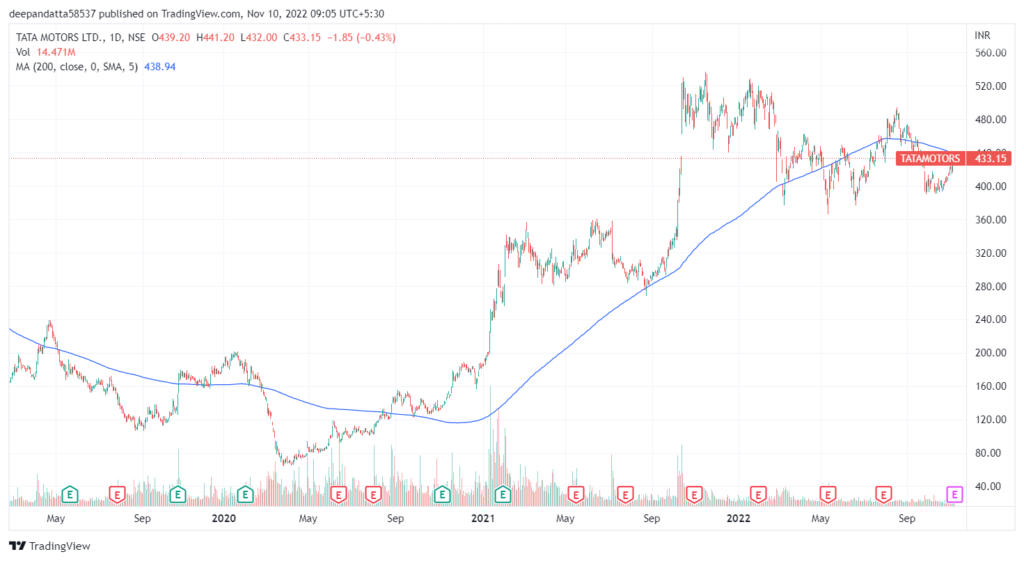Table of Contents
The company that investors and the d-street once gave up on due to its dismal financial performance, deteriorating fundamentals, and consistent decline in stock price is now a case study of a successful business turnaround. Tata Motors share price has given a CAGR of 35% in the last three years and a market cap of $20.25 billion as of November 2022.
So, what has changed for the company, what is the long-term growth outlook, and how much is the upside potential of the Tata Motors share price? We will try to uncover everything in this blog.
Overview of Tata Motors
History
Tata Motors began as Tata Engineering and Locomotive Company (TELCO) in 1945 as a manufacturer of locomotives. It entered the manufacturing of commercial vehicles in 1954 in collaboration with Daimler-Benz AG and started manufacturing passenger vehicles in 1988 with the launch of the Tata Mobile-206 pick-up vehicle.
Today
Tata Motors is a sizeable international automobile player with a diverse product range, including commercial, passenger, military, electric, and luxury vehicles, and a vehicle financing arm, Tata Motors Finance. In FY 2021-22, the consolidated revenue of Tata Motors was ₹ 2,78,454 crores with an EBITDA margin of 9.6%.
With the size of the business, multiple business heads, and operations spanning over 125 countries, analyzing the business and factors affecting Tata Motors share price becomes highly complex.
We will break down each of Tata Motors business segments to understand the business in a better way.
Commercial Vehicles
Tata Motors is an established player in the commercial vehicle (CV) segment, and its vehicles are not a miss on Indian roads, from the hinterland to expressways. Despite the presence of other major brands, the market share of Tata Motors in the CV segment is 44.9% in FY-2022, up by 2.5% compared to the previous year. The company has improved its market share by 250 bps in the last two quarters.
Tata Motors is a leader in all product ranges, from small commercial vehicles medium and heavy commercial vehicles to buses and vans. In FY 2022, the segment contributed 18.8% to the consolidated revenue. The revenue during the same period registered a year-on-year growth of 57.9% to reach ₹ 52,287 crores, as economic recovery aided the growth. However, EBITDA reported a decline of 150 bps at 3.7%.
In the Q2 of FY 2023, the company’s EBITDA margin improved by 180 bps to reach 5%, despite the global headwinds, rise in commodity prices, and strong US dollar. One of the key emerging growth engines in the CV segment is electric mobility. The company delivered 250+ electric buses in FY 2022 and forayed into cargo E-mobility with the launch of the ACE EV.
Passenger Vehicles
The turnaround in the passenger vehicles segment is miraculous and helped the company to overhaul its image of a dying company that was thriving on the trust of Tatas. By replacing the old product line-up with cars having futuristic designs and top-notch safety levels, Tata Motors was able to win back the trust of Indians.
The segment reported consolidated revenue of ₹ 31,515 crores in FY 2022, a growth of 89.8% Y-o-Y contributing 11.3% to the total revenue. From a market share of just 4.8% in FY 2020, the Tata Motors passenger vehicle segment is now close to becoming the second-largest player, and its market share in H1 FY 2023 is 14.1%.
Also, the segment has become EBITDA positive from FY 2021, and in the Q2 of FY 2023, the EBITDA margin came in at 5.4%, registering a slight decline of 70 bps Q-o-Q. During FY 2022, despite significant supply-side bottlenecks, the company successfully ramped up its manufacturing volumes by 67%, compared to the industry average of 13%.
Electric Vehicles
The one segment that hogged the limelight is the Tata motors electric vehicle segment, with its pace in expanding its product portfolio and sales volume growth.
Tata Motors enjoys the dominant position in the EV market with 87% market share in FY 2022, reporting a 353% Y-o-Y growth in sales volume to 19,105. The company also ramped up its EV charging infrastructure and is present in over 2000 locations.
In FY 2022, the company transferred its passenger EV business to a newly formed subsidiary, Tata Passenger Electric Mobility Limited (TPEML), with an initial capital of ₹ 700 crores and raised $1 billion through TPG global at a $9.1 billion valuation.
Jaguar Land Rover
The luxury vehicles segment contributes 67.4% to the total consolidated revenue and impacts Tata Motors share price the most.
Due to the semiconductor shortage, the segment is witnessing pressure, and the annual sales volume in FY 2022 declined 15.8%, with EBITDA suffering a 250bps decline. Therefore, the company focused on producing high-margin products to drive EBITDA margins.
The Q2 FY 2023 earnings report shows some positive developments. JLR revenue is up 36% year-on-year at £5.3 billion in Q2. Better availability of semiconductor chips also increased volumes by 17.6% y-o-y and 4.9% q-o-q growth.
The division reported a free cash flow of negative £1156 million in FY 2022 and expects to near breakeven in the current fiscal year. Better availability of semiconductor chips can further improve sales volume in the second half of FY 2023. JLR, in its quarterly disclosure, stated that its total order book stands at 205,000 units.
Tata Motors Finance
It is the vehicle financing arm of the business, and commercial vehicle financing is the primary focal point. In FY 2022, its loan book witnessed 5.6% growth to ₹45,220 crores and the Net NPA ratio deteriorated by 180 bps to 5.4%.
Tata Motors Financial Performance
Revenue
During FY 2022, the revenue from standalone business (India operations) came in at ₹ 47,263.68 crores, up from ₹ 30,175.03 crores in FY 2021, marking a turnaround in domestic operations. In Q2 of FY 2023, revenue recorded a 35.93% y-o-y jump at ₹ 14,947 crores. The consolidated revenue (global operations) came in ₹2,78,453.62 crores in FY 2022. And, in Q2 of FY 2023, revenue jumped by 29.7% to ₹79,611 crores.
EBITDA
EBITDA for the standalone business stands at ₹ 747.93 crores in September 2022 quarter, up by 76.02% from ₹ 424.90 crores in September 2021. Tata Motors consolidated EBITDA margin in the FY 2022 was 9.6%.
With improving business conditions and sales, the company is steadily improving its EBITDA margin. In Q2 of FY 2023, the company’s EBITDA margin improved by 130 bps y-o-y to 9.7%. As a result, the auto major narrowed its net losses in the September 2022 quarter to ₹ 944.61 crores from ₹4441.57 crores a year ago.
Key Financial Ratios
Interest Coverage Ratio: The consolidated Interest coverage ratio on 31st March 2022 stands at 0.19 times vs. 1.49 times on 31st March 2021. Lower earnings from both India and global operations resulted in the decline of the interest coverage ratio.
Current Ratio: The current ratio in FY 2022 improved slightly to 0.98 times from 0.93 times in FY 21.
Debt-to-equity Ratio: The debt-to-equity ratio deteriorated further in FY 2022 to 3.13 times from 2.46 times in the previous year. It is due to losses during the year and the increase in consolidated debt by 2.8%.
Operating Profit Margin: The operating profit margin during the FY 2022 declined from 11.86% in the previous year to 8.7% due to a decline in revenue, a rise in the cost of goods, and manufacturing expenses.
Net Profit Margin: The net profit margin improved from negative 5.36% to negative 4.06% in FY 2022. It was due to low depreciation costs and high one-time exceptional expenses.
Tata Motors Share Price Analysis
Tata Motors shares were listed on BSE in 2000. The company launched its IPO on 3rd January 2000 with an issue price of ₹ 38.64 a share. The stock was split in the ratio of 10:2 on 12th September 2011, and the current face value of the stock is ₹2.
Over the 10 years, Tata Motors share price has underperformed compared to its peers; however, the turnaround in business in the last three years has resulted in stock price growth. As a result, Tata Motors share price has registered a CAGR of 36% in the last three years.

The Tata Motors share price chart above shows that the stock made a low of ₹63.60 on March 25th, 2020, and is currently trading close to ₹400. The 52-week high for Tata Motors share price is ₹536.70. The company last paid a dividend of ₹0.20 in 2016 and had stopped paying dividends due to losses recorded in the business.
Key Risks
The key risks that could impact Tata Motors share price are:
- CV is a cyclical business, and any downturn in the economy can impact its recovery and growth
- High input costs and delays in price hikes could impact the return to profitability roadmap and goal of zero net debt by 2024
- Global supply chain constraints and shortage of semiconductor chips
- High petrol prices can impact growth in the PV segment
Tata Motors’ investment in future mobility and its plans to launch 10 EVs by 2025 can offset some of the risks in the business, providing an upside to Tata Motors share price.
The details shared above are based on the quarterly and annual reports of Tata Motors and are for information purposes only. However, we suggest doing your due diligence before you make investment decisions.
Disclaimer Note: The stocks and financials mentioned in this article are for information purposes only. They shouldn’t be considered as a recommendation by Research & Ranking. We will not be liable for any losses that may occur.
FAQs
How has Tata Motors share price performed in the last three, five, and ten years?
In the last three, five, and ten years, Tata Motors share price has given a CAGR of 36%, 1%, and 5%, respectively. On March 25th, 2020, Tata Motors share price hit a low of ₹63.5 and is currently trading around the ₹400 level.
What is the top-performing business segment of Tata Motors?
JLR contributes almost 70% to the total revenue and profits and is the critical driver of Tata Motors share price.
What is the market capitalization of Tata Motors?
At the current Tata Motors share price, the market capitalization of Tata Motors is close to ₹1.5 lakh crores.
Read more: About Research and Ranking
How useful was this post?
Click on a star to rate it!
Average rating 5 / 5. Vote count: 1
No votes so far! Be the first to rate this post.
























